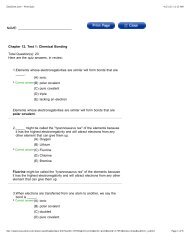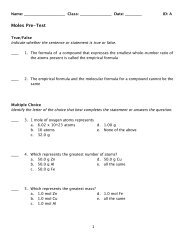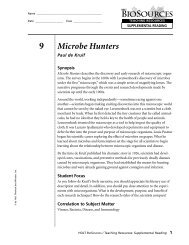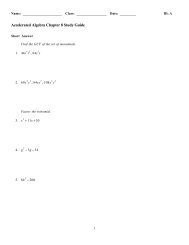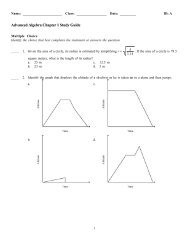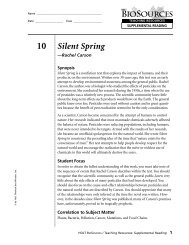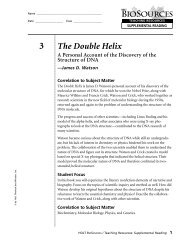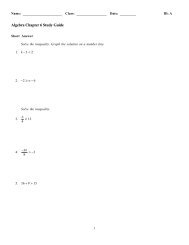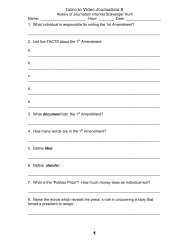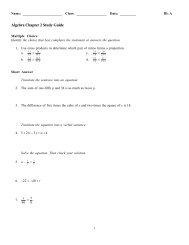Chapter 4 â Consumer and Producer Surplus
Chapter 4 â Consumer and Producer Surplus
Chapter 4 â Consumer and Producer Surplus
- No tags were found...
Create successful ePaper yourself
Turn your PDF publications into a flip-book with our unique Google optimized e-Paper software.
GoldwasserAP Microeconomics<strong>Chapter</strong> 4 – <strong>Consumer</strong> <strong>and</strong> <strong>Producer</strong> <strong>Surplus</strong>BEFORE YOU READ THE CHAPTERSummaryThis chapter develops the concepts of producer surplus, consumer surplus, <strong>and</strong> totalsurplus <strong>and</strong> then illustrates the connection between these concepts <strong>and</strong> the dem<strong>and</strong> <strong>and</strong>supply model. The chapter also explains how total surplus can be used to the gains fromtrade <strong>and</strong> to evaluate the efficiency of a market.<strong>Chapter</strong> ObjectivesObjective #1. The dem<strong>and</strong> <strong>and</strong> supply model illustrates how much consumers <strong>and</strong>producers gain from participating in a market. A consumer’s willingness to pay refers tothe maximum price the consumer would pay to purchase an item. The dem<strong>and</strong> curve isdefined by the willingness of consumers to pay.Objective #2. An individual’s consumer surplus is the difference between the individual’swillingness to pay <strong>and</strong> the price he/she pays for the good: consumer surplus measures thenet gain the consumer receives when he/she purchases the good. Total consumer surplusis the sum of the individual consumer surpluses achieved by all the buyers of the good.Total consumer surplus is equal to the area under the dem<strong>and</strong> curve but above the price.• The area of consumer surplus is a triangle for a smooth dem<strong>and</strong> curve or a series ofrectangles for a step-shaped dem<strong>and</strong> curve.• Holding everything else constant, a decrease in price increases consumer surpluswhile an increase in price decreases consumer surplus.Objective #3. The seller’s price is the lowest price the seller is willing to sell the good for.Individual producer surplus is the difference between the price the good sells for <strong>and</strong> thelowest price the seller is willing to accept for the good: individual producer surplusmeasures the net gain the seller receives from selling the good. Total producer surplus isthe sum of the individual producer surplus achieved by all the sellers of the good. Totalproducer surplus is equal to the area above the supply curve but beneath the price.• The area of producer surplus is a triangle for a smooth supply or a series ofrectangles for a step-shaped supply curve.• Holding everything else constant, a decrease in price decreases producer surplus<strong>and</strong> an increase in price increases producer surplus.
Objective #4. Total surplus is the sum of consumer <strong>and</strong> producer surplus. At the marketequilibrium, total surplus is maximized: the market equilibrium allocates the consumptionof the good among potential consumers <strong>and</strong> the sales of the good among potential sellersin order to achieve the maximum possible gains to society. In a well-functioning market,total surplus cannot be increased by reallocating consumption among consumers,reallocating sales among sellers, or by changing the quantity traded. In fact, each of theseactions diminishes the level of total surplus in the market.• Preventing a sale in a market that would have taken place in equilibrium reducesboth the consumer <strong>and</strong> producer surplus, resulting in a loss of total surplus.Increasing sales beyond the equilibrium quantity similarly reduces consumersurplus, producer surplus, <strong>and</strong> total surplus since such a sale would represent asituation where the buyer’s willingness to buy must be less than the seller’s cost.Objective #5. Total surplus is maximized at the market equilibrium: (a) the marketallocates consumption of the good to those potential consumers who place the highestvalue on the good; (b) the market allocates sales of the good to the sellers who have thelowest cost of producing the good; (c) the market ensures that any purchase represents asituation where the buyer values the good more than the seller values the good; <strong>and</strong> (d)the market ensures that no sales are made in which the seller values the good more thanthe purchaser does. Markets are efficient when total surplus is maximized.• Even though the market equilibrium maximizes total surplus, this does not implythat it maximizes the outcome for any individual buyer or seller. Subsequentchapters consider situations of market intervention where individual buyers orsellers are made better off than they would be at the market equilibrium.Objective #6. Well-defined property rights are required for a market to functioneffectively. Well-defined property rights identify the owner of valuable resources <strong>and</strong>goods, <strong>and</strong> this ownership makes it possible for mutually beneficial transactions to occur.Economic signals are also necessary for markets to function. The best economic signal isprice because price of a good conveys the consumer’s willingness to pay <strong>and</strong> theproducer’s cost.Objective #7. Markets can fail to be efficient: this is called market failure. Markets failwhen someone prevents mutually beneficial trades from occurring, when there are sideeffects that the market does not take into account, or because some goods are unsuited forefficient management by markets. Subsequent chapters consider these situations.
Key Termswillingness to pay the maximum price aconsumer is willing to pay for a goodindividual consumer surplus the netgain to an individual buyer for thepurchase of a good: equal to thedifference between the buyer’swillingness to pay <strong>and</strong> the price paidtotal consumer surplus the sum of theindividual consumer surpluses of all thebuyers of a good in a marketconsumer surplus a term often used torefer both to individual consumersurplus <strong>and</strong> to total consumer surpluscost (of seller) the lowest price at whicha seller is willing to sell a goodindividual producer surplus the net gainto an individual seller from selling agood; equal to the difference betweenthe price received <strong>and</strong> the seller’s costproducer surplus a term often used torefer both to individual producer surplus<strong>and</strong> to total producer surplustotal surplus the total net gain toconsumers <strong>and</strong> producers from tradingin a market; the sum of the producersurplus <strong>and</strong> consumer surplusproperty rights the rights of owners ofvaluable items, whether resources orgoods to dispose of those items as theychooseeconomic signal any piece ofinformation that helps people makebetter economic decisionsinefficient describes a market ofeconomy in which there are missedopportunities; some people could bemade better off without making otherpeople worse offmarket failure occurs when a marketfails to be efficientNotes
AFTER YOU READ THE CHAPTERTipsTip #1 To master the key concept in this chapter, you must be able to locate theareas of surplus in the graphs of the supply <strong>and</strong> dem<strong>and</strong> model. You will want towork with the concepts of consumer surplus, producer surplus, <strong>and</strong> total surplusuntil you feel confident you can find these areas in your graphs.Tip #2 Figure 4.1 illustrates the concept of consumer surplus for a step shapeddem<strong>and</strong> curve. The area of consumer surplus consists of a series of rectangles thatlie under the dem<strong>and</strong> curve but above the market price. Each of these rectangleshas been shaded separately in Figure 4.1 but the area of consumer surplus is theentire shaded area. Those consumers whose willingness to pay is equal to orgreater than the market price will purchase the good for the market price, <strong>and</strong> theirconsumer surplus represents the net gain they receive from purchasing the good.Tip #3 Figure 4.2 illustrates the concept of consumer surplus for a smooth dem<strong>and</strong>curve. The area of consumer surplus consists of the area under the dem<strong>and</strong> curvebut above the market price. In figure 4.2, the area of consumer surplus is shaded.The value of consumer surplus can be found by calculating the area of this shadedtriangle. The consumer surplus represents the net gain consumers receive frompurchasing a good.
Tip #4 Figure 4.3 illustrates the concept of producer surplus for a step-shapedsupply curve. The area of producer surplus consists of a serried of rectangles thatlie above the supply curve but below the market price. Each of these rectangles hasbeen shaded as separate rectangle in Figure 4.3, but the area of producer surplus isthe entire shaded area. Those producers whose willingness to sell is equal to or lessthan the market price, will sell the good for the market price, <strong>and</strong> their producersurplus represents the net gain the receive from selling the good.Tip #5 Figure 4.4 illustrates the concept of producer surplus for a smooth supplycurve. The area of producer surplus is the shaded region above the supply curvebut beneath the market price. The value of producer surplus can be found bycalculating the area of this shaded triangle. The producer surplus represents the netgain producers receive from selling the good.
Tip #6. Figures 4.5 <strong>and</strong> 4.6 illustrate total surplus, which the sum of consumersurplus <strong>and</strong> producer surplus. Figure 4.5 illustrates this concept for step-shapeddem<strong>and</strong> <strong>and</strong> supply curves, <strong>and</strong> Figure 4.6 illustrates this concept for smoothdem<strong>and</strong> <strong>and</strong> curves.Tip #7. If you are using flash cards, make sure you make up a set with this chapter’snew vocabulary <strong>and</strong> concepts. Review all of your flash cards on a regular basis tomake sure you are not forgetting <strong>and</strong> terms or concepts.




